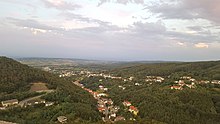Forchtenau (municipality of Forchtenstein)
|
Forchtenau cadastral community Forchtenau
|
||
|---|---|---|
|
|
||
| Basic data | ||
| Pole. District , state | Mattersburg (MA), Burgenland | |
| Judicial district | Mattersburg | |
| Pole. local community | Forchtenstein | |
| Locality | Forchtenstein | |
| Coordinates | 47 ° 43 '17 " N , 16 ° 22' 12" E | |
| Residents of the stat. An H. | 732 (January 1, 2017) | |
| Area d. KG | 874.76 hectares | |
| Statistical identification | ||
| Cadastral parish number | 30104 | |
| Counting district / district | Forchtenau (10602 00) | |
| Source: STAT : index of places ; BEV : GEONAM ; GIS-Bgld | ||
Forchtenau is one of the two cadastral communities in the Forchtenstein community . The name appears for the first time in a deed of donation from Count von Mattersdorf in 1202. Here it is described as uninhabited woodland.
history
Emergence
Around 1300 the Counts of Mattersdorf started building a castle, which appeared in 1672 with the name "Burg Pfortenstein". A few residents soon settled below this castle and in 1343 the village "Ferchiton" was established. A few years later, Bishop Albert of Nicomedia consecrated a small church in honor of Saint Michael. Over the years the name of the place has changed frequently: 1343 Ferchiton, 1344 Frakno, 1346 Fahruhno, 1356 Vorchtenstain, 1425 Vorchtnaw, 1435 Frathnow, 1441 Vorchtnaw, 1461 Vorivhtenaw, 1526 Forchtenstein, 1552 Forchtenau, 1625 Fracno aliter Forchtenau, 1889 Frakno. Some names were derived from the Middle High German word "vorhe", which meant fear. With this name one wanted to scare the attackers in advance. In the 15th century the possession of the castle fell into the hands of the Habsburgs, so that by 1526 51 houses were counted. Furthermore, this place was at that time the largest wine-growing area in which predominantly white wine, which was already divided into categories of quality wine, mediocre wine, and table and table wine, was grown.
Development from the 17th century
At the beginning of the 17th century (1622) Nikolaus Esterházy took over the castle and manors of Forchtenstein and Eisenstadt. A few years later, the castle was expanded. A castle chapel, a treasury and living quarters were built.
In the middle of the 17th century (1651) a common elementary school was built for the towns of Forchtenau and Neustift an der Rosalia . However, the children were only taught together until 1986, after which they were taught in separate schools. In 2004 the schools were again merged.
Towards the end of the 17th century (1695) the church was handed over to the Servites by Prince Paul I of Esterhazy. They took care of it until 1981.
Natural disasters, fires and epidemics followed, which restricted the development of the place. Because of an extreme fire in 1877, the Forchtenau volunteer fire brigade was founded.
In 1898 it was determined that the place may only be called under the Hungarian name "Fraknò".
A total of 72 Forchtenauer and Neustifters died in the First World War. Subsequently, on August 21, 1921, Burgenland was annexed to Austria and in April 1938 out of 798 people entitled to vote, 796 voted for an annexation of Austria to Germany. There are no more written documents from the community for the following war years from 1939 to 1945.
In 1971 the communities Forchtenau and Neustift an der Rosalia merged and the name "Forchtenstein" was decided. Josef Wutzelhofer was elected as mayor.
literature
- Ernst Herzog: Forchtenau / Frakno, Neustift ad Rosalia / Ùjtlek, Forchtenstein, once & now , 2010, home publisher
Individual evidence
- ^ Forchtenstein primary school , accessed on January 27, 2018.


